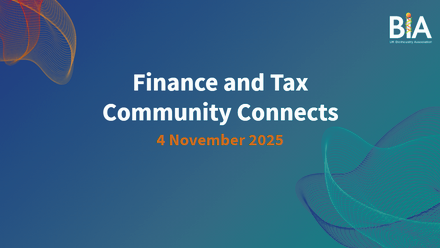Draft Finance Bill gives key features of future R&D tax regime but questions remain

On 18 July, the Government published the draft Finance Bill and supporting policy documents providing key features and the direction of travel in the ongoing R&D tax relief reforms. Our Head of Policy and Public Affairs, Martin Turner, and Chair of BIA’s Finance and Tax Advisory Committee, Colin Hailey, take a closer look.
The Government has published draft legislation on the further support for R&D intensive SMEs that BIA secured at Spring Budget 2023 and also confirmed that an enhanced rate will continue to be available to qualifying SMEs following the ongoing R&D tax relief reforms. This is really welcome and delivers on a key policy call from BIA.
As part of the reforms, the Government consulted in January on the design of a merged, simplified R&D tax relief and committed to publishing draft legislation in the summer. They have now published a draft legislation and a policy paper setting out the proposed design. Alongside this, the Government has also published a summary of responses to the consultation on merging schemes. A decision on whether to merge schemes will be made at the next fiscal event – probably an Autumn Statement in November. This is also when any decisions on the rate of relief given to companies will be confirmed.
Below we have set out the key features of a merged R&D relief scheme detailed in the legislation and policy paper, but there are many details yet to be decided and revealed by the Government. We are pleased to see some of BIA’s key requests for features of the new regime have been adopted by the Treasury, most notably an enhanced rate for R&D intensive SMEs and the continued ability to claim for outsourced activity i.e. the costs of third party R&D vendors such as CROs.
Overview
Two new R&D reliefs will replace the existing R&D Expenditure Credit (RDEC) scheme mainly used by large companies and the SME R&D tax credit scheme. The two reliefs are as follows:
Merged scheme:
- Available to all sizes of company, with a credit rate of 15% after tax
- The Government has yet to commit to introduce the merged scheme
R&D intensive SME scheme:
- Available to SMEs that are R&D intensive, with a cash credit rate of 27% for loss-making companies. This is higher than the rate under the current SME scheme for R&D costs incurred since 1 April 2023
- This scheme uses the old SME R&D credit rules, but only applies to a R&D intensive companies
- The Government has committed to introducing this scheme
- The remainder of the SME R&D credit rules will be replaced if the merged scheme is introduced
The costs that can be included in these two schemes are identical, so loss-making companies making cash claims would receive more under the R&D intensive SME scheme
The merged scheme
This proposed scheme includes features of the old RDEC and SME schemes. A name for the new scheme is yet to be decided.
Proposed introduction date:
- Accounting periods beginning on or after 1 April 2024
Conditions:
- The claimant company is working on its own R&D projects, or
- The work is subcontracted to it by a non-UK customer
Potentially, the expenditure will not be able to be subsidised, though a decision on this has not yet been made. Spend is subsidised when the cost is directly or indirectly met by someone else.
For groups of companies, it is the company that is doing the R&D work that is entitled to claim, even where it is being paid to do that work by another group company.
Qualifying R&D spend:
- Staff
- Consumables (including cloud and data costs)
- 65% of externally provided workers (agency staff)
- 65% of subcontractors – subject to being UK or Qualifying Overseas Expenditure
Subcontractor work done in the UK will qualify. Work done overseas can only be included if it would be wholly unreasonable for the work to be done in the UK, but inclusion on those grounds due to cost or availability of workers is not permitted.
Rate:
- Profitable companies will receive a taxable credit of 20% of the above spend. After corporation tax at 25%, this is worth 15%
- Loss making companies can receive a cash credit of 15%
Caps on claims:
- The amount of any cash credit is limited to three times the PAYE and NI liabilities of the company for the period. An exemption will be given for companies creating or managing IP
This ‘PAYE cap’ is the same as currently exists in the SME R&D credit system, for which the BIA secured the key exemption that applies to most BIA members.
R&D intensive SME scheme
Introduction date
- Spend on or after 1 April 2023
Conditions:
- Claimants must be SMEs
- Spend cannot be subsidized i.e. met directly or indirectly by someone else
- The company must have an R&D intensity of 40% for the period. This is determined by dividing R&D spend (see qualifying spend below) by the total spend. Note that connected parties spend must be included, i.e. group companies and companies under control of the same investor
Spend is only included in R&D intensity if it is corporation tax deductible, so spend in non-UK companies is ignored.
Qualifying spend:
- Staff
- Consumables (including cloud and data costs)
- 65% of externally provided workers (agency staff)
- 65% of subcontractors – subject to being UK or Qualifying Overseas Expenditure
These are all the same as for the merged scheme. Subcontractor work done in the UK will qualify. Work done overseas can only be included if it would be wholly unreasonable for the work to be done in the UK, but inclusion on those grounds due to cost or availability of workers is not permitted. HMRC has published draft guidance on these rules, which BIA has fed back on but we await the final guidance.
Rate:
- The company obtains an additional tax deduction of 86% of its spend. Therefore if profitable its total tax deduction is worth 46.5% (being 186% @ 25%)
- If loss-making, the company can surrender its 186% at 14.5% for a cash credit, a cash credit rate of c.27%
Cap on claims:
- As above for the merged scheme. The amount of any cash credit is limited to three times the PAYE and NI liabilities of the company for the period. An exemption will be given for companies creating or managing IP. This ‘PAYE cap’ is the same as currently exists in the SME R&D credit system
Remaining questions
This is just draft legislation and proposals so nothing is confirmed yet. We also understand a number of features consulted on are still under consideration and could be included in the final merged scheme. This includes a minimum claim threshold to exclude smaller claims (e.g. <£10,000) and how specialist R&D service providers will be able to claim.
Non-compliance in the system
Also last week was the publication of HMRC’s Annual Report and Accounts, which showed non-compliance – claims for activity that does not qualify as R&D – is significantly higher than previously estimated; 16.7% in 2020-21, costing the taxpayer £1.13 billion, compared to the previously published estimate of 3.6% (£336 million). Given this, HMRC also published their Approach to R&D tax reliefs, outlining the steps they are taking to tackle fraud, and will be following up with a more detailed plan on how they plan to reduce non-compliance in Winter 2023.
This non-compliance is the driver behind many of the negative changes to the regime over recent years, including the PAYE cap and SME rate cut. It has also resulted in the introduction of more red tape and checks on claims, which we know have been frustrating for BIA members, who are genuine R&D claimants. Given the vital support R&D tax reliefs provide to innovative sectors like life sciences, BIA supports efforts to cut fraud and ensure the reliefs are sustainable in the future, but we are urging Treasury and HMRC to achieve this in a proportionate way that does not harm sectors of the economy that are clearly doing R&D and not committing fraud.
What next
This is an important milestone in the reforms that BIA and our Finance and Tax Advisory Committee has been closely engaged with. It’s important to note that this is draft legislation for consultation so is likely to be significantly amended and added to as the Government’s policy on the future regime develops. The Treasury is also keen to stress that no final decision has even been made on introducing a merged scheme.
We have already met Treasury officials for a preliminary conversation about the draft legislation and will be having more detailed discussions in the coming weeks. We will also formally respond to the proposals in writing. Key in our mind is delivering an internationally-competitive R&D tax relief rate for SMEs. The enhanced rate we secured at Spring Budget was welcome but still below what France offers and the 33% rate previously available in the UK. This needs to be remedied and we also need to see how the R&D intensive definition works in practice.
The government welcomes comments on the technical detail of the draft legislation as part of the technical consultation process for the draft Finance Bill. The deadline for this is 12 September 2023. If you would like to provide any feedback, please email [email protected]. BIA would also like to hear your views, which you can send to [email protected].
We will set out some further implications of these schemes in future BIA blogs.






